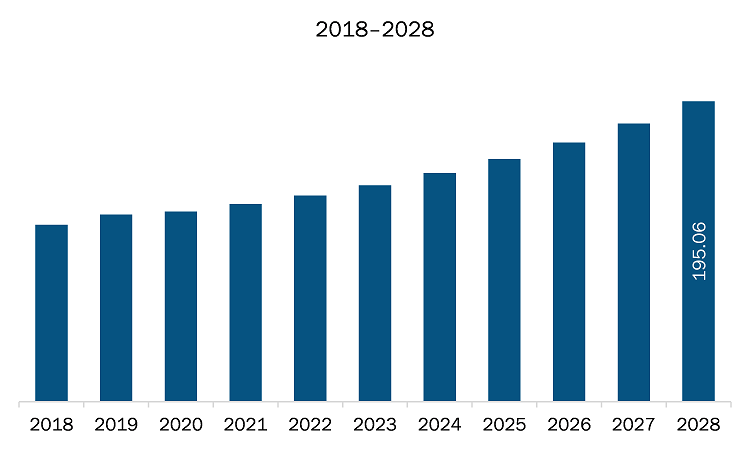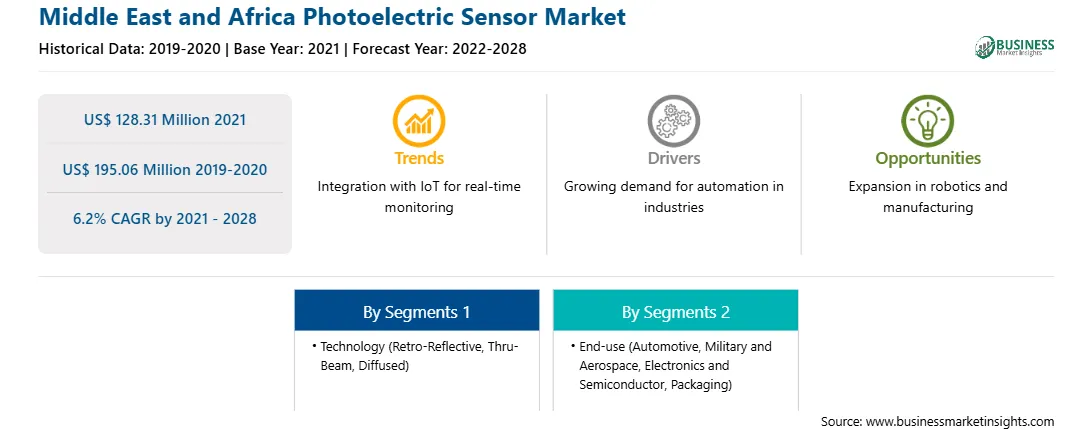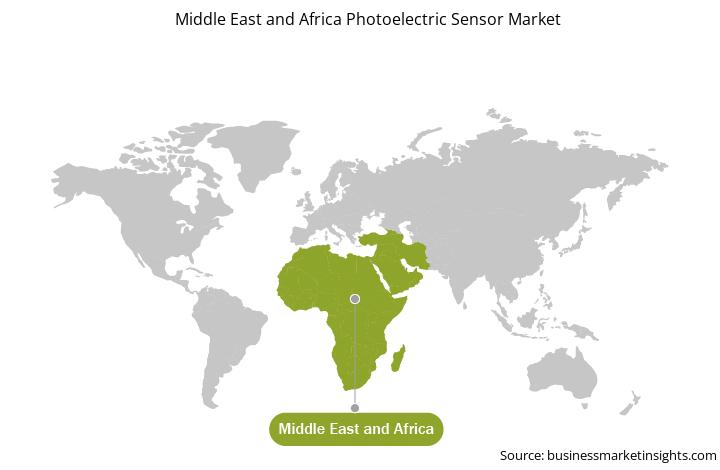The Middle East countries are looking ahead for the adoption of value-added logistics services for industries. However, urbanization in the Middle Eastern region is transforming the outlook of countries. The MEA stands among the world’s fastest-growing market for logistics and transportation sector, with strong infrastructure presence in Dubai and Abu Dhabi turning is turning them into global hubs. Continuous growth in industrialization in Saudi Arabia is pushing the country toward integration of automated supply chain within different industries. Saudi Arabia is witnessing balanced development due to the continuous support from government for the industrialization in Yanbu and Jubail. The government initiatives to encourage the manufacturing sector of the MEA region are increasing the demand for photoelectric sensor. For instance, Dubai has established one of the biggest industrial exhibition event for attracting new manufacturers. Major manufacturing industries in Dubai include rubber, plastics, food & beverages, printing and publishing, base metals, oil & gas, petroleum, and electrical equipment and machinery. Several factors, such as increase in passenger cars and commercial vehicles on the road, rise in demand for electric vehicles, and introduction of automated technology integrated cars, are positively affecting the automotive industry in the region. For, instance, in 2020, 720,156 units of vehicles were produced in Africa. Thus, the increasing car production and sales across the region is also influencing the growth of the photoelectric sensor market. Other Middle East countries such as Oman and Israel are also expected to witness growth in its manufacturing sector. The Oman government is supporting manufacturing industry by introducing several incentives as well as FDI promotions. Further, it has created special economic zones to enhance manufacturing growth. Also, Israel has a robust aerospace industry. Thus, the above-mentioned factors are contributing to the growth of the photoelectric sensor market over the years in the region.
The major countries in the MEA facing the economic impact of COVID-19 pandemic include Saudi Arabia, the UAE, Egypt, Morocco, and Kuwait. The region is projected to register a swift decline in exports due to lowered demands for raw materials and products from manufacturers across North America, Europe, and APAC; this can be attributed to lowered production activities and disruption of manufacturing in many countries in these regions. Irrespective of the previous projections regarding steady growth of the photoelectric sensor market in the MEA due to escalating adoption of the IIoT, to enhance resource utilization, improve efficiencies, and enhance worker safety, in Saudi Arabia and the UAE, the imposition of travel restrictions and disruption of supply chains are limiting the photoelectric sensor market growth to a certain extent.

Strategic insights for the Middle East and Africa Photoelectric Sensor provides data-driven analysis of the industry landscape, including current trends, key players, and regional nuances. These insights offer actionable recommendations, enabling readers to differentiate themselves from competitors by identifying untapped segments or developing unique value propositions. Leveraging data analytics, these insights help industry players anticipate the market shifts, whether investors, manufacturers, or other stakeholders. A future-oriented perspective is essential, helping stakeholders anticipate market shifts and position themselves for long-term success in this dynamic region. Ultimately, effective strategic insights empower readers to make informed decisions that drive profitability and achieve their business objectives within the market.

| Report Attribute | Details |
|---|---|
| Market size in 2021 | US$ 128.31 Million |
| Market Size by 2028 | US$ 195.06 Million |
| CAGR (2021 - 2028) | 6.2% |
| Historical Data | 2019-2020 |
| Forecast period | 2022-2028 |
| Segments Covered |
By Technology
|
| Regions and Countries Covered | Middle East and Africa
|
| Market leaders and key company profiles |
|
The geographic scope of the Middle East and Africa Photoelectric Sensor refers to the specific areas in which a business operates and competes. Understanding local distinctions, such as diverse consumer preferences (e.g., demand for specific plug types or battery backup durations), varying economic conditions, and regulatory environments, is crucial for tailoring strategies to specific markets. Businesses can expand their reach by identifying underserved areas or adapting their offerings to meet local demands. A clear market focus allows for more effective resource allocation, targeted marketing campaigns, and better positioning against local competitors, ultimately driving growth in those targeted areas.

The photoelectric sensor market in Middle East & Africa is expected to grow from US$ 128.31 million in 2021 to US$ 195.06 million by 2028; it is estimated to grow at a CAGR of 6.2% from 2021 to 2028. Photoelectric sensor are gaining popularity due to their high reliability and long-range object detection capabilities, irrespective of the size, shape, color, material, and surface properties of objects. These sensor are designed to operate under harsh conditions; moreover, they are enabled with advanced technologies to ensure reliable suppression of undesirable reflections. These abilities makes them more versatile than many other sensor types and appropriate for industrial usage. For instance, retro reflective sensor with polarization filters detect the position of carriage of any shape and material, which is to be kept on and off the track of a rollercoaster. Further, photoelectric sensor are widely used in the military and aerospace industries owing to their high accuracy and reliable performance. They are used in cargo aircraft for smoke and fire detection. In addition, photoelectric sensor help airframe and engine manufacturers to monitor aerospace system parameters such as pressure, temperature, acceleration, optical position, and speed. Moreover, the defense industry is extensively using biological detection equipment for detecting the presence of chemical substances in environment and for assessing the risk of potential biological threats by detecting harmful biological materials, to safeguard both military and civilian populations. Thus, the accuracy and reliability of photoelectric sensor operations make them a preferred sensor type in harsh industrial conditions.
In terms of technology, the retro-reflective segment accounted for the largest share of the Middle East & Africa photoelectric sensor market in 2020. Further In term of end-use, the automotive segment held a larger market share of the photoelectric sensor market in 2020.
A few major primary and secondary sources referred to for preparing this report on the photoelectric sensor market in Middle East & Africa are company websites, annual reports, financial reports, national government documents, and statistical database, among others. Major companies listed in the report are Autonics Corporation; Balluff GmbH; Eaton Corporation plc.; ifm electronic GmbH; OMRON Corporation; Rockwell Automation, Inc.; Panasonic Corporation; SICK AG; and Schneider Electric SE among others.
The Middle East and Africa Photoelectric Sensor Market is valued at US$ 128.31 Million in 2021, it is projected to reach US$ 195.06 Million by 2028.
As per our report Middle East and Africa Photoelectric Sensor Market, the market size is valued at US$ 128.31 Million in 2021, projecting it to reach US$ 195.06 Million by 2028. This translates to a CAGR of approximately 6.2% during the forecast period.
The Middle East and Africa Photoelectric Sensor Market report typically cover these key segments-
The historic period, base year, and forecast period can vary slightly depending on the specific market research report. However, for the Middle East and Africa Photoelectric Sensor Market report:
The Middle East and Africa Photoelectric Sensor Market is populated by several key players, each contributing to its growth and innovation. Some of the major players include:
The Middle East and Africa Photoelectric Sensor Market report is valuable for diverse stakeholders, including:
Essentially, anyone involved in or considering involvement in the Middle East and Africa Photoelectric Sensor Market value chain can benefit from the information contained in a comprehensive market report.